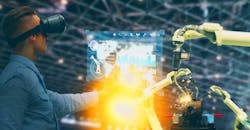Eight Drivers for Manufacturing’s Next 50 Years
Part of the series 2070: A Manufacturing Odyssey
In the last several decades, we’ve seen major disruptions to the manufacturing environment. We experienced the “China Price,” which prompted offshoring of manufacturing operations, nearly decimating U.S. manufacturing. More recently we’ve seen the trend toward personalized products, resulting in smaller lot sizes, thus straining traditional economies of scale production. And the “Amazon Effect” of rapid turnaround in orders and delivery times of two days or less continues to challenge the longer lead times typical in manufacturing.
Now we are seeing digital solutions that are both an opportunity and a curse. An opportunity to upgrade manufacturing operations and create more flexibility and to take advantage of interoperability of equipment, software and solutions. A curse without a strong guiding vision and the capabilities to actually upgrade.
So what might manufacturing look like in 2030, or 2070? In some instances, it will look much the same as it does today. We will still have large-volume, low-mix operations that will continue to harvest the advantages of economies of scale production. However, the competitive dynamics of manufacturing will change for a large portion of the traditional manufacturing world. Proactive strategy will become the norm as machines become smart and interconnected systems cooperate. Distributed production systems, fueled by local resources, will compete successfully with incumbents. Digital dexterity in workers and leaders will be required. New business models will compete with traditional contracting mechanisms to share value creation and this will change the roles and responsibilities across the supply chain. Africa will rise as a competitive player; with their natural resources, they could leapfrog the more traditional players. Finally, data will be king. Simulations will drive decision-making, and everything from design to production and reverse logistics will be honed to maximize efficiency.
Here are eight drivers to this future.
1. Quality will still be Job 1, but how we achieve it will change. With sensors everywhere, critical operational variables will be exposed. Predictive maintenance will be the norm and unplanned downtime will be drastically reduced. Moreover, individual machines can be run close to their tolerance limits since sensors will be able to identify the machine’s ability to meet part needs. The same sensors that will provide machine health will also enable real time feedback as software algorithms link directly into control systems to continuously assess the best operating parameters. These feedback loops will be augmented with feedforward loops to improve yield, anticipating how future steps in the operating process might be tweaked to correct or improve quality.
2. Economies of scale will coexist with economies of one production. 3D printing/additive manufacturing technologies will have matured and will be cost competitive. These technologies will be integrated and linked seamlessly with more traditional processes. 3D printing will accommodate the smaller batch sizes driven by personalization, but will require different ways of certifying quality. In this low volume production world, a blockchain or other distributed ledger framework will capture the materials, processing environment, design and layer-by-layer quality and thus will provide a snapshot of the entire part production that will be accepted by the buyer. Of course, in the next decade our ability to determine layer-by-layer quality will rely on vision systems, in-process sensors, and complex algorithms that have yet to be developed.
3. Production will become more localized. With 3D printing technologies, the critical inputs will be the raw materials. Production will be more closely tied to either the location of these raw materials or the location of the customer. We are already seeing the large shipping companies investing in 3D printing technologies in anticipation of this.
4. People will still be involved in manufacturing, but their roles will be different. Automation will continue to replace repetitive tasks, and the costs of robots and their control systems will decline to a point where even smaller manufacturers can take advantage of them. Manufacturing work will become more strategic, more proactive, and more transparent.
5. Product design will become more naturalistic. Products will be made through naturalistic design and their materials will be functionally graded to combine materials in new ways. The product features will be paired to the specific materials and we will see combinations of materials not possible today. Think organics and electronics embedded together onto a flexible infrastructure for example. Algorithms will enhance this through simulation where features can be optimized before any physical work is done. The engineers of the future will be trained for both subtractive and additive processes, and will have a deep knowledge of biologically derived structures and digital tools.
6. AI (artificial intelligence in today’s vernacular) will be associated with augmented intelligence. Humans and digital tools will not only coexist; they will be tightly integrated. Wearables and exoskeleton supports will increase human performance and improve safety.
7. The ecosystem of today, driven by transactions, will be based more on relationships. Strategic partners will collaborate to create end-to-end solutions that manufacturers can deploy with limited tweaking. The data-sharing conundrum of today will be solved through new business models that expose the value of sharing data, while also protecting the underlying intellectual property.
8. Manufacturing operations will be guided by a unified architecture that links the edge (asset) to the cloud. We will consciously deploy digital tools and will understand and manage the tradeoffs between compute location, storage, data rates, and communication bandwidth, for example. In this architecture, security will be baked in and not an add-on feature. Systems will be open and interoperable, using general computing technology rather than proprietary systems.
This future world is not an impossibility. It will require strong leaders who can role-model behaviors around digital transformation and who are prepared to embrace digital tools, engage their workers, and collaborate with suppliers. The future is not for the faint of heart, but it is coming nonetheless.
Irene Petrick is senior director of the Industrial Innovation/IIoT Group, Intel.
